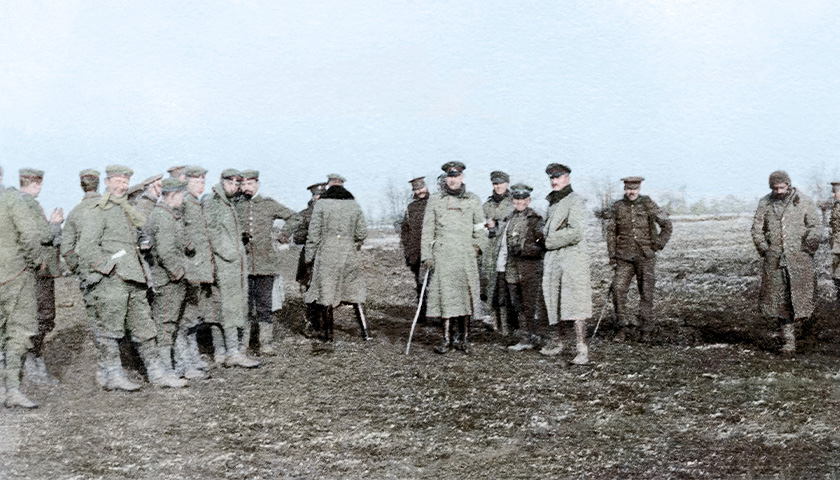by Jon Miltimore
War had already been waging in Europe for months when Pope Benedict issued a plea from Rome on Dec. 7, 1914 to leaders of Europe: declare a Christmas truce.
Benedict saw how badly peace was needed, even if it was only for a day. The First Battle of Ypres alone, fought from October 19 to November 22, had resulted in some 200,000 casualties (mostly German and French soldiers, but also thousands of English and Belgians). The First Battle of the Marne was even worse.
In light of this carnage, the pope asked “that the guns may fall silent at least upon the night the angels sang.”
The European leaders ignored his plea.
Then something miraculous happened on the eve of Christmas. From No Man’s Land—the area between the trench works of Allied and Central forces—German troops, in a spontaneous act, put down their weapons and invited English soldiers to celebrate Christmas with them. It’s remembered today as the Christmas Truce.
The British cartoonist Bruce Bairnsfather was one of many who chronicled the event. A machine gunner in the 1st Battalion of the Royal Warwickshire Regiment, Bairnsfather was shivering in the muck of a three-foot trench on a cold night, munching on stale biscuits and chain-smoking, when he heard a noise at about 10 p.m. Via History:
“I listened,” he recalled. “Away across the field, among the dark shadows beyond, I could hear the murmur of voices.” He turned to a fellow soldier in his trench and said, “Do you hear the Boches [Germans] kicking up that racket over there?” “Yes,” came the reply. “They’ve been at it some time!”
The Germans were singing carols, as it was Christmas Eve. In the darkness, some of the British soldiers began to sing back. “Suddenly,” Bairnsfather recalled, “we heard a confused shouting from the other side. We all stopped to listen. The shout came again.” The voice was from an enemy soldier, speaking in English with a strong German accent. He was saying, “Come over here.”
After some back and forth talk, British troops laid down their weapons, climbed out of their trenches, crossed the barbed wire, and joined the Germans. They traded handshakes and songs; they chewed tobacco and drank wine and laughed together—these men who earlier that day had been doing their best to kill each other.
Some accounts describe German and British soldiers playing “football” (soccer) on makeshift fields. Others mention British soldiers setting up barbershops and offering haircuts in exchange for cigarettes. The one thing all the accounts have in common is a general feeling of merriment among the soldiers.
“There was not an atom of hate on either side,” Bairnsfather recalled.
Afterwards, not everyone was pleased with the gaiety. Some military leaders reportedly seethed over the Christmas truce. But Bairnsfather suggests the soldiers themselves cherished the moment, which they sorely needed.
“For those who participated, it was surely a welcome break from the hell they had been enduring. When the war had begun just six months earlier, most soldiers figured it would be over quickly and they’d be home with their families in time for the holidays. Not only would the war drag on for four more years, but it would prove to be the bloodiest conflict ever up to that time.”
I’ve always found the Christmas Truce moving, and also telling. While the leaders of Europe may have loathed one another, the German and English people clearly did not, at least not once they met one another.
On that Christmas night, the nationalism that had divided German and British soldiers evaporated when they met face-to-face, traded, laughed, drank, and discovered their common humanity.
I recently read Stille Nacht (Silent Night): The Story of the Christmas Truce—a new children’s book written by Rory Margraf—to my youngest son. He had many questions, but mostly he wanted to know why the soldiers were fighting in the place. (I suspect many soldiers—Belgians and Germans, French, Englishmen, and beyond—themselves wondered this very same thing many times during that war.)
I didn’t have a good answer for him. But I’ve thought on the matter some since, and I think the Christmas Truce holds a clue about why we fight.
People who for weeks and months had been shooting and bombing one another found themselves laughing, singing, and trading—and they did so because they defied their orders. The sad truth is nation-states—which throughout history have done a magnificent job of convincing humans that people they never met are their enemy—often are not particularly interested in peace.
“War is the health of the state,” the radical writer Randolph Bourne famously noted.
The truth is waging war is what government does best, and the people who wage them and win are the ones lauded in the history books. The losers, of course, are not; which makes winning a war that has begun all the more important. (It’s also important to point out that the people who declare wars rarely see their own blood spilled during them.)
I don’t wish to oversimplify something as serious and terrible as war, but I do wish to demonstrate there is another way. The Christmas Truce shows us that peace is achieved by rejecting statism and nationalism and collectivism in all forms; it is won by embracing our common humanity and the things that bring us together.
Even bitter enemies can become friends when we reject violence and see people as they truly are—as individuals. (Especially on Christmas, a holiday that celebrates the birth not of a conqueror, but of a lamb.)
The British and German troops who on Christmas Eve enjoyed one night of joy amid the carnage of 1914 could attest to that.
– – –
Jonathan Miltimore is the Managing Editor of FEE.org. His writing/reporting has been the subject of articles in TIME magazine, The Wall Street Journal, CNN, Forbes, Fox News, and the Star Tribune.
Photo “German and British Troops During the Christmas Truce of 1914” by Cassowary Colorizations. CC BY 2.0.








